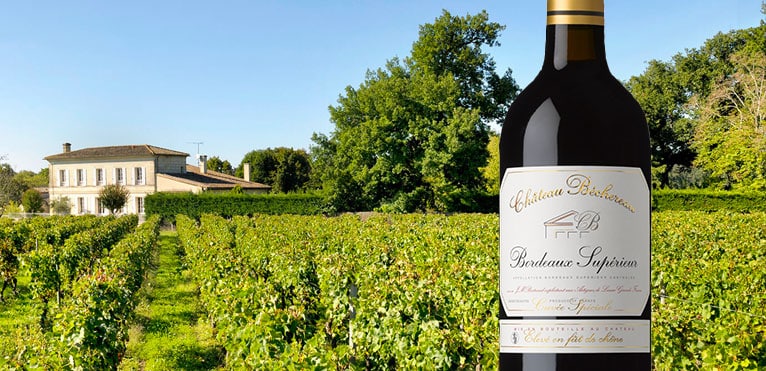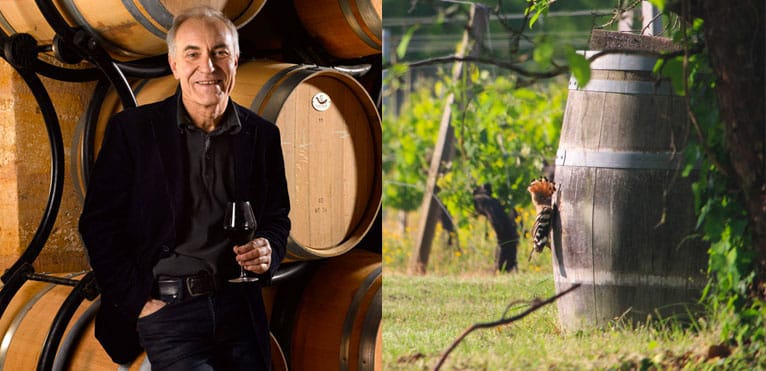
Contents
Château Béchereau’s 25 hectares of vines flourish near the Bordelais village of Lussac. Divided into three terroirs, the vineyards produce three AOCs: Bordeaux Supérieur from the clay-gravel soils of Artigues-de-Lussac, particularly well-suited to Merlot; Lalande-de-Pomerol from the clay-sand soils of Néac; and Montagne-Saint-Emilion from the clay-limestone soils of Montagne.
History and know-how
From the 1950s onwards, Robert and Suzanne Bertrand ran the vineyard using traditional techniques, and later handed over the reins to their son Jean-Michel and his wife Simone. This introduces in 1973 bottled at the château as a guarantee of quality.
In the 1990s, their daughter Chantale and her husband Joël Dupas took over the family business at Château Béchereau. They take advice from oenologist Mickael Laizet from Michel Rolland’s Bordeaux oenology laboratory.
The majority of the vineyards are planted with Merlot (85% of the surface area), Cabernet Sauvignon, Cabernet Franc and Malbec. The vines are constantly monitored, harvested by machine and then meticulously sorted by hand. The winemaking process and ageing are made entirely on the estate, thanks to a meticulous mastery of traditional know-how that is also innovative.
Experimentation and innovation are at the heart of our business: Joël Dupas is a visionary winemaker.
Château Béchereau likes to experiment and go back to the past: the vinification and ageing of the rosé and Malbec varietals take place in terracotta and sandstone jars, in the style of antiquity, to preserve all the purity of the fruit. This taste for experimentation is motivated by the desire to improve quality and to satisfy and surprise our customers.

Eco-responsible commitment
In 2015, Joël set up an innovative wine storehouse at the château that consumes very little water and electricity, using mass rather than mechanical thermal regulation.
Joël Dupas determined that this technique was unsuitable for white and rosé wines, whose aromatic potential is highly dependent on temperature, and so decided to use the winery for Lalande-de-Pomerol production.
The cellar’s stone walls guarantee the thermal inertia of the winery, whose insulation has been consolidated. This naturally heats the barrels as the temperature of the fermenting vats rises. The filled barrels are rolled several times a day to help extract the polyphenols. This cellar is dedicated solely to vinification, to avoid contamination. Once vinified, the wine is pumped to another cellar for ageing.
Thanks to this system, the vineyard’s electricity consumption has fallen by 25%. No cooling system is used for alcoholic maceration and fermentation, and no water is used during this time.
Château Béchereau is committed to offering cuvées that are both tasty and respectful of the environment, with a focus on combining tradition and innovation.
The vintages
The château offers a selection of emblematic vintages from the Bordeaux region.
La Cuvée Tradition in Bordeaux Supérieur is vinified and aged in stainless steel or concrete vats. It exalts aromas of red fruits and spices, and its supple tannins make it smooth and creamy. The spicy Lalande de Pomerol offers structured, elegant tannins.
La Cuvée Spéciale in Bordeaux Supérieur is vinified in vats and aged for 12 months in barrels. A structured, fresh wine with notes of blackberry and cherry and secondary aromas of vanilla. Lalande de Pomerol is a fine, fruity wine with round, soft tannins. Its elegance earned it a place in the Hachette guide in 2003, 2004, 2013, 2018, 2019 and 2020. Montagne Saint-Emilion is a well-balanced, full-bodied wine with rich black fruit aromas, which also featured in the Hachette guide in 2006 and 2012.
La Cuvée Expression de Béchereau is vinified and aged in new barrels. Lalande de Pomerol is 100% Merlot. This ageing wine reveals notes of greedy red fruit and spices such as cardamom and pepper. It will feature in the 2019 and 2020 Hachette wine guides.
Two new red wine cuvées were launched in 2015: Cuvée Couleur Malbec which, as its name suggests, gives pride of place to Malbec with its aromas of blackberry and black cherry, and the cuvée Epiphanie with notes of black fruit and surprising volume after opening.
Château Bécherau also produces a rosé vinified entirely in earthenware jars. An atypical rosé, it reveals aromas of red fruit and violets on the palate.
Photos : Château Béchereau